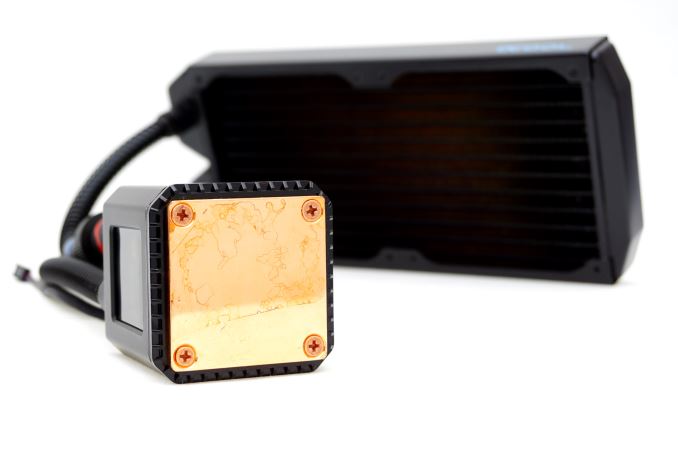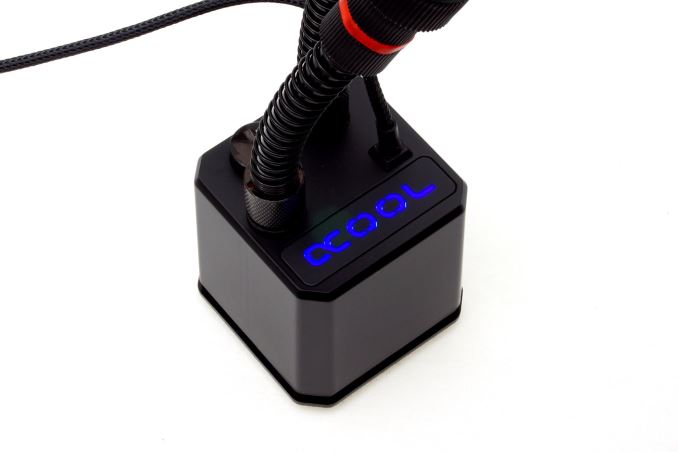The Alphacool Eisbaer 240 CPU AIO Liquid Cooler Review
by E. Fylladitakis on August 1, 2016 9:00 AM EST- Posted in
- Cases/Cooling/PSUs
- AIO
- Water Cooling
- Cooler
- Alphacool
Conclusion
In this review we had a look at Alphacool’s latest product and first AIO liquid cooler, the Eisbaer, which the company is marketing as an “extremely quiet, expandable solution”. It is true that the supplied 120 mm “Eiswind” fans did perform very well and that the ceramic pump is practically noiseless, making the Eisbaer 240 the least noisy AIO liquid cooler that we have tested to this date. Our only concern lies with the long term reliability of the fans, as while sleeve bearing engines are amongst the least noisy options, they lack the long-term reliability of other solutions that are noisier or expensive.
While the Eisbaer 240 did not outperform every other similar cooler in terms of raw thermal performance, it possibly has the best noise/performance ratio of every dual 120 mm fan AIO cooler available today. It could likely outperform several of its competitors if stronger fans were to be used, but we feel that Alphacool’s choice of fans in terms of noise performance hits the mark. Users can fall into two categories - thermal or acoustic performance, and a user that places acoustic comfort above a slim difference in thermal performance will do well here. Even with its quiet fans, the thermal performance of the Eisbaer is very good and more than adequate for the typical gamer/enthusiast that simply wants a cool and quiet high performance system.
The expandability of the Eisbaer 240 is one of the primary focus points of Alphacool’s marketing team. It is true that the Eisbaer 240 is very versatile, offering expansion options depending on the user’s skill and needs. It has a quick release connector on the tubing for users that want to keep things simple and expand using parts that the company supplies specifically for the Eisbaer, plus the company has simple tube compression fittings installed on every part that allow the user to completely remove the tubing if necessary. The Alphacool Eisbaer 240 practically is a standard, divisible liquid cooling kit that is being supplied preassembled and prefilled by the company.
Expanding the Eisbaer may be a relatively simple process but the user has to take into account the impact that the expansion will have on the performance of the system. For example, the insertion of a GPU block will add both resistance and thermal energy into the system, respectively reducing the flow of the pump and increasing the load of the radiator. A second radiator will offer quicker thermal energy dissipation but significantly burdens the pump. In theory, a single loop can be expanded to cover multiple GPU blocks and more than one radiator but, as the pump cannot be upgraded, we advise against the installation of more than three items per system. It is technically possible to add an external pump into the system but that would beat the purpose of having an AIO solution in the first place, as a customized kit would perform better and cost less at this point. Alphacool has informed us that they are currently designing a similar AIO liquid cooler for GPUs, the GPX-Pro. When the GPX-Pro becomes available, the interconnection between the two system will be possible, allowing them to share their radiators and double the pressure (but not the flow) of the pumps. Whether having the two systems interconnected will perform better than keeping them separated is a complicated discussion that depends on many specific details, such as the CPU/GPU, the position of the radiators, the strength of each pump, the usage of the system, etc., preventing us from being able to provide a simple and definite answer.
Alphacool currently retails the Eisbaer 240 in Europe for €115 incl. VAT plus shipping costs. Slightly lower pricing may be found via some of their local resellers. In the US, the Eisbaer 240 is available for $120 plus shipping. The price is higher than that of most similar competitive products, but reasonably so for a product that offers an expandable setup with a copper radiator and high thermal performance combined with near-silent operation. We highly recommend it to those seeking a low noise AIO cooling solution, especially when there is a significant preference for potential future expansions/upgrades.












69 Comments
View All Comments
MobiusPizza - Monday, August 1, 2016 - link
The author says this cooler has best noise/thermal performance ratio, but looking at the graphs the CoolerMaster H110 seems to have both lower noise level and lower thermal resistance?retrospooty - Monday, August 1, 2016 - link
Yeah, I am really not getting the need for water cooling these days. Today's Core i5/i7 CPU run extremely cool... Even if you are overclocking, there are little to no benefits of using water. It adds complexity with no benefit. I have a Core i5 Skylake with a BeQuiet shadow rock 2 cooler, and I dont even plug in the fan at all. I can run prime - 100% CPU utilization for hours and hours with no fan at all and it doesn't even get warm, not even a little... and I live in Arizona and its summer. There just isnt a need for water anymore, even if you are overclocking the hell out of it.nightbringer57 - Monday, August 1, 2016 - link
Think about people still rocking a good old FX8350 like me ;)And AIO watercooling still happens to be competitive in high perf / small cases (typically mini ITX) setups, where clearance around the CPU is often very limited (typically, the PSU is in the way and forbids anything but very low-profile coolers), but can fit 1 or 2 12cm fans.
retrospooty - Monday, August 1, 2016 - link
Agreed, if you have an AMD CPU, you can benefit from water cooling. Some high end video cards as well... but AMD CPU's and high end video cards get hot as hell. My comment was on Intel CPU's. I would have a hard time recommending anyone buy an AMD CPU these days, regardless of the cooling used. Hopefully the upcoming Zen processor changes that. It would be great to go AMD again if they can be competitive.nightbringer57 - Monday, August 1, 2016 - link
edit: and Intel power consumption climbs up if you get into the more high-end platforms (like the X79/X99 platforms). Especially on tinier mainboards (think: mini ITX X99 ones) where you don't have standard cooler mounting holes but the special I-can't-remember-the-name ones. In those cases, big coolers don't fit. But a waterblock happily does.retrospooty - Monday, August 1, 2016 - link
I dont know... My core i5 6600k cooled as described above is a Mini itx case. Even if it were a smaller case, with no room for a huge tall cooler, there are options that work great.nightbringer57 - Monday, August 1, 2016 - link
It depends on your case.And as explained, your i5 is not realy an "enthusiast" CPU, even if it's a great CPU in itself.
And the options that work great in more confined cases... Do not work quite as great as your typical AIO watercooling system, even if those have difficulties getting significantly better results than average-to-high-end aircooling systems.
It's a niche, yes. But I wouldn't say this niche doesn't exist.
retrospooty - Monday, August 1, 2016 - link
Agreed, in some cases water would be better, AIO cases is a good example... But if you buy an AIO with water cooling, it comes pre-built and you dont do anything with it... The product above would not be for that. Also, if you have an older system you want to keep and improve the old air cooler, it might be good too depending on what you have... I guess what I am getting at, is if you were putting together a new system as of today (as opposed to upgrading an older one) you would be better served to by a case and an air cooler. They have tons of options of all sizes. Let me put it another way, if were building a new system as of today and you chose parts (case and CPU) that would benefit from water cooling, you probably chose badly.nightbringer57 - Monday, August 1, 2016 - link
When I say "AIO", I mean "AIO liquid cooler" (such as in this review), not "AIO computer" ;)And no, cases that cannot fit a good air rad (so limit the choice to either low profile rads or AIO liquid cooler) simply allow you to have a more compact PC, so they are not a bad choice, they answer different needs.
retrospooty - Monday, August 1, 2016 - link
Got it... I am paying attention LOL ;) I do see your point, I just dont think alot of people have that need. Like I said, if today (and that today part is a key thing here) were building a system, I cant see picking any case and CPU that would require something like the product above. If you are into massive overclocking, a tiny mini ITX case that cant fit a normal size air cooler probably isnt the best choice. There are plenty of mini ITX cases that can fit air coolers of any size and need. If you are overclocking and need something really small that cant fit a full size air cooler, OK... But if that is the case someone chose, where would they put the radiator? I know there are answers to that question and ways to do it, but extreme niche is what I am hearing.